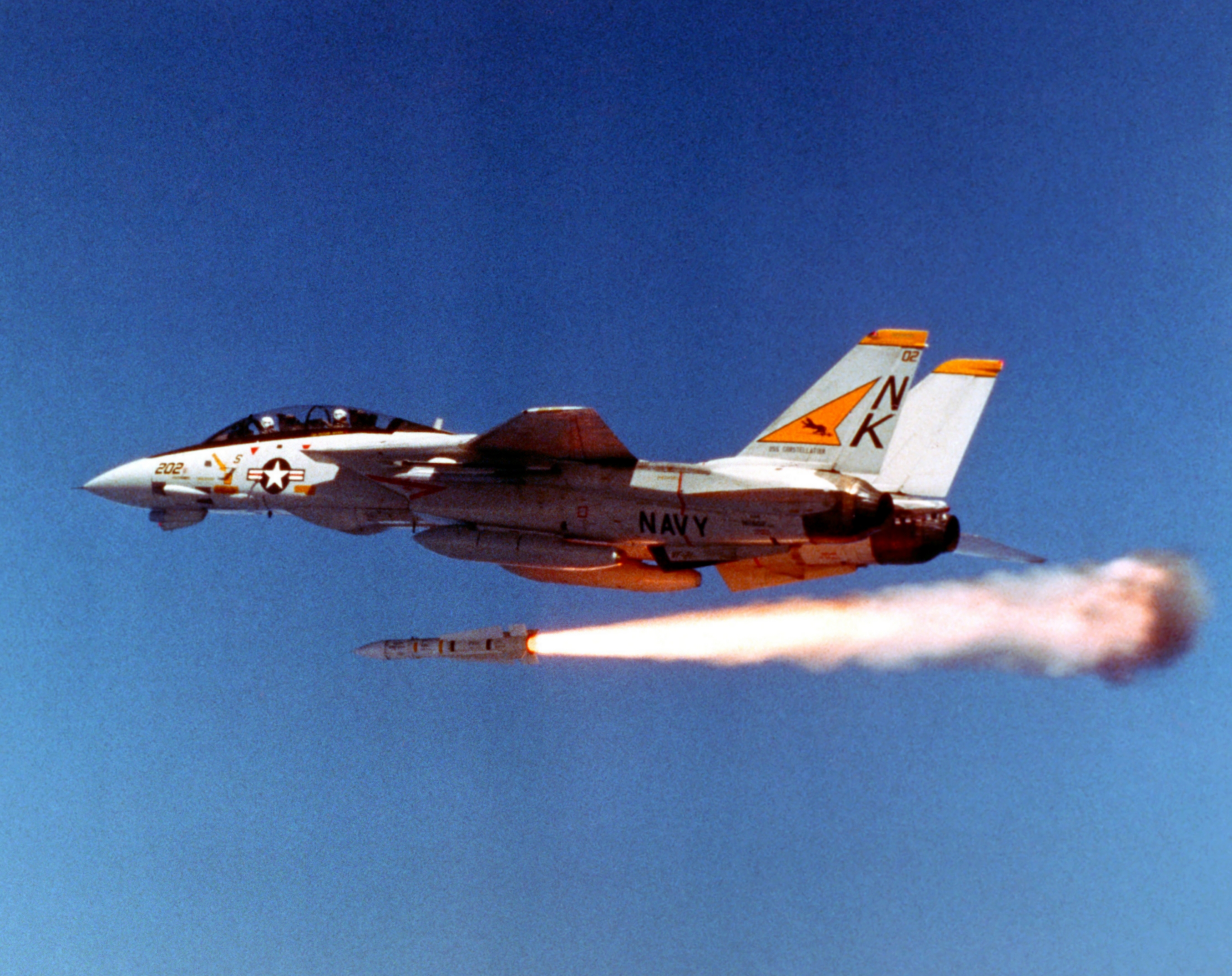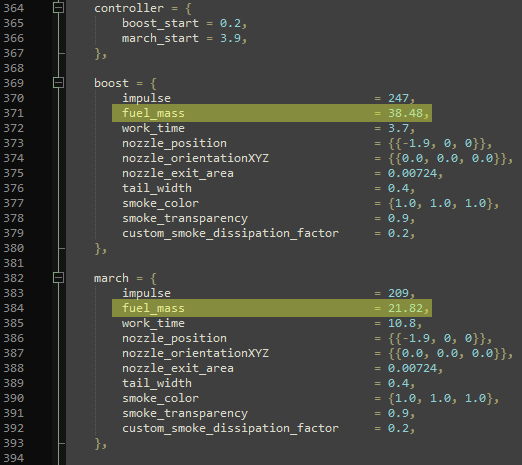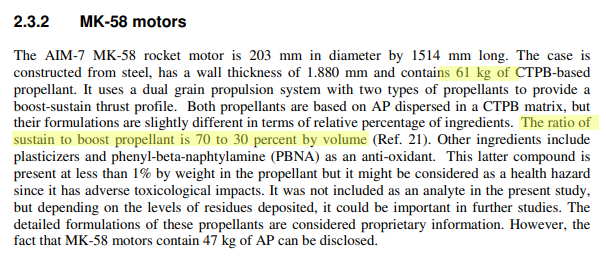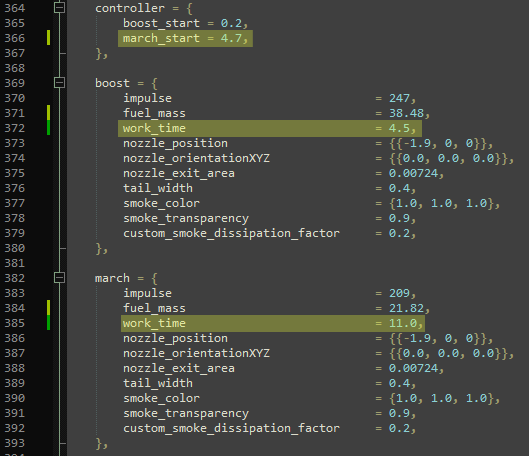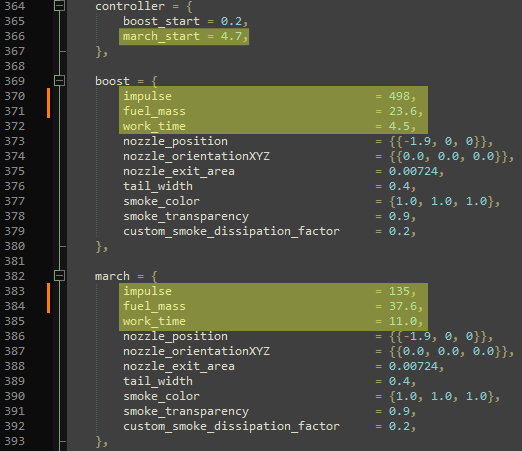-
Posts
87 -
Joined
-
Last visited
Content Type
Profiles
Forums
Events
Everything posted by Prez
-
Callsigns + Airframe: [Alamo] Prez - F-15E [Alamo] Dundun92 - F15E [Alamo] Sizzle - F15E [Alamo] moldy - F-15E [Alamo] Patatoorlog - F-15E [Alamo] TrueMetroMan- F-15E
- 46 replies
-
- 1
-

-
- pg97
- persian gulf 1997
- (and 5 more)
-
Would it not be worth it to at least take another look at the actual thrust values? Especially, since the ones in DCS are underperforming, albeit a few percentages, compared to not only my references, but the references of Maestro who is behind the code itself. Burn time as well is corroborated between my sources and all but one of Maestro’s. Even if this is not changed immediately or shelved for the time being, I think it’s still worth taking a look at especially when the corrections I made resulted in a missile that is not so far off what is currently in game. Thank you.
-
A slight error on my part with this: the Canadian MK-58 study states a 70/30 “volume” ratio, but I misread it as a mass ratio. I believe I overlooked it since the ratio was fairly close to the mass ratio anyways. I apologize for that error.
-
Preface: The main purpose of this post is not to strictly improve the missile performance itself, but to correct values in the AIM-7 missile Lua code that are not accurate to the publicly available information. Any improvement to the performance of the missile should be seen as a side effect and not the intended purpose. This post seeks to compare several public sources on the AIM-7's Hercules MK-58 rocket motor to what is actually modeled in game, and contrast them accordingly. Tests were done using a modified AIM-7F utilizing the "corrected" values to showcase the differences to the vanilla missile. Only the AIM-7F was used for testing as the kinematics between each variant carrying the MK-58 rocket motor are practically negligible. The Tacview files will be provided in this post. The ED AIM-7 vs Public Data: 1. Rocket Motor Burn Time According to ED's missile code (Fig. 1), the AIM-7 has a booster stage burn time of 3.7 seconds, and a sustainer burn time of 10.8 seconds for a total run time of 14.5 seconds not including the 0.2 second delay for the boost ignition and 0.2 second delay for the sustainer ignition. However, according to the "Raytheon AIM-7F Standard Missile Characteristics" data sheet (Fig.2), "AD-A-142508" (Fig.3) and "Gallery of USAF Weapons, 2010 Almanac" (Fig. 4) the stated burn time for the boost stage is 4.5 seconds and the sustainer stage is 11 seconds for a total run time of 15.5 seconds. This is one full second, not including ignition delays, of difference between the ED code and public information. This may be a negligible difference, but there is a conversation about edge cases where the one extra second may matter. Figure 1: Default Eagle Dynamics AIM-7 MK-58 motor code Figure 2: Raytheon AIM-7F Standard Missile Characteristics Engine Ratings Figure 3: AD-A-142508 AIM-7F data sheet Figure 4: Gallery of USAF Weapons, 2010 Almanac AIM-7 data sheet 2. Boost and Sustain Fuel Mass and Mass Ratios Looking at the ED code (Fig.5) boost stage for the MK-58 has a fuel mass of 38.48kg (84.83lbs), and the sustainer stage has 21.82kg (48.10lbs) of propellent for a total mass of 60.3kg (132.9lbs). The sustainer-to-booster propellent mass ratio is approximately 63/37. However, comparing this to the Raytheon propellent masses (Fig. 6) the boost phase contains 52.0lbs (23.6kgs) of propellent and the sustainer fuel mass is 83.0lbs (37.6kg) for a total of 135.0lbs (61.2kgs). The sustainer-to-booster propellent mass ratio with this information is approximately 39/61. The actual masses of propellent in each stage are practically the same with only an error of 7.5%(smaller mass) and 2.3%(larger mass), but reversed in ratio. According to a Canadian study of the Mk-58 Mod 5 rocket motor, there are no listed measurements for the individual propellent masses except for a total fuel mass of 61kg (134lbs). However, the stated sustainer-to-booster propellent mass ratio is 70/30 (Fig. 7) which leads to a booster fuel mass of roughly 18.3kg (40.3lbs), and a sustainer fuel mass of roughly 42.7kg (94.1lbs). Neglecting that the Mod 5 version of the motor may have slightly different masses for each stage, the point stands that the ED MK-58 is coded to have a complete reversal of the publicly available data on the propellent mass and mass ratios for each stage. This will lead to noticeable differences in the performance of each stage as we will see in the test portion of this post. Figure 5: ED AIM-7 fuel mass code Figure 6: Raytheon AIM-7 SMC Fuel data Figure 7: Canadian MK-58 study 3. Boost and Sustain Specific Impulse Values As stated in the ED AIM-7 code (Fig. 8.), the specific impulse for the boost phase of the MK-58 motor is 247 seconds, and 209 seconds for the sustainer phase. Using the ED values, and a gravity value of 9.8 m/s2, we get a boost phase thrust of approximately 25.174kN (5659lbf), and a sustainer phase thrust of approximately 4.138kN (930lbf). Now, according to both the Raytheon AIM-7 SMC (Fig. 2) and the AD-A-142508 (Fig. 3), the stated thrust of the boost phase is 5750lbf (25.577kN), and 1018lbf (4.528kN) for the sustainer. Note that the ED values are underperforming, but can be considered negligible as there is only an error of about 1.6% and 8.6% and motor performance varies with many factors. Using the ED values for both thrust and fuel mass, but correcting the fuel ratios and burn time for each stage, we get a boost phase specific impulse of 530 seconds and sustainer phase of 121 seconds. This is quite a dramatic difference in performance between the actual ED missile and this theoretical "corrected" motor with the boost phase being over twice as efficient, but the sustainer being nearly half as efficient. Now, this may seem as though the performance of the missile may also dramatically improve, but, as we will see in the tests, this is not the case. This is a minimum however as the ED missile uses a lower thrust and fuel mass compared to the public data, so there may be performance left on the table. If we use only public data to formulate the specific impulse of each stage then we get a boost phase of 498 seconds and a sustainer phase of 135 seconds. We will see how this version of the missile compares to the ED one as will. Figure 8: ED AIM-7 specific impulse code In-Game AIM-7F Tests: Test Parameters: Game Version: 2.9.1.48335 Map: Marianas Weather, Date, Time: Mission Editor defaults Launch Platform: F-15C Launch Altitude: ~40,000ft Launch Speed: ~1.5 IMN Target Platform: MiG-19P Target Altitude: ~40,000ft Target Speed: ~1.2 IMN Test 1: Control: Test 2: Corrected Burn Times: Test 3: Corrected Burn Time, ED Fuel Mass, Corrected Ratio: Test 4: Corrected Burn Time, ED Fuel Mass, Corrected Ratio, and Specific Impulse: Test 5: AIM-7F Public Data Only: Conclusions: First, comparing the control missile to the missile from Test 2, we see that the change in burn time yields practically zero difference in peak energy states. However, it can be said that the extra time in the boost phase and overall longer burn time will help in edge cases where a slightly longer burn time would result in better terminal energy. Looking at Test 3, we see that the acceleration observed at each stage is dramatically different where the majority of the acceleration of the missile is felt during the sustain phase rather than the boost phase, and the overall acceleration of the missile is much smoother reminiscent of the AIM-54's motor. Yet, again, the missile does not yield any noticeable improvement to peak energy state, but it can be said that this could perhaps drastically improve the performance of the AIM-7MH and P missiles as the loft maneuver is less than optimal which depletes the effectiveness of the MK-58's boost stage. This is just speculation though. Next, we see that in Test 4 we finally yield some peak energy improvements however small. It is worth noting that the energy graph has now returned to shape of the vanilla missile with the boost phase taking the brunt of the acceleration leg work. Although the gains are small, this would still result in a better missile with the extended burn time and slightly higher peak energy state, however marginal. Finally, we arrive at Test 5 using only public data. This missile yields the best peak energy state gaining as much energy over Test 4 as Test 4 gains over Test 1. Again, the energy graph is practically a replica of the vanilla one in terms of shape. Although the specific impulse of the boost phase is lower than that of Test 4 the sustainer is higher, and this results in the higher energy state as Test 5 would have higher actual thrust values compared to the ED numbers. It is important to note that Test 4 and 5, where the sustainer specific impulses are lower than the vanilla, would indicate that overall performance may be worse against a maneuvering target, but, again, this is just speculation since the test was done against a cooperative target. Overall, ED has done a fair job at replicating the AIM-7's MK-58 motor performance using "incorrect" fuel ratios and specific impulses, but it is unfortunate that it has been done with "incorrect" information. I believe that the closer we can get to real values (as long as they are public, of course) the better the simulation will be. References: 1. Raytheon AIM-7F Standard Missile Characteristics: http://aviationarchives.blogspot.com/2016/08/raytheon-aim-7f-standard-missile.html 2. Gallery of USAF Weapons, 2010 Almanac: https://www.airandspaceforces.com/PDF/MagazineArchive/Magazine Documents/2010/May 2010/0510weapons.pdf 3. AD-A-142508: https://apps.dtic.mil/sti/pdfs/ADA142508.pdf 4. Canadian MK-58 Mod 5 study: https://apps.dtic.mil/sti/pdfs/ADA596430.pdf AIM-7F Corrected Burntime.acmi AIM-7F Vanilla.acmi AIM-7F Public Data Only.acmi AIM-7F Corrected Burntime+Fuel Mass+Impulse.acmi AIM-7F Corrected Burntime+Fuel Mass.acmi
-
Squadron Name: Alamo Aggressors Aircraft Selection: F-15C/E, J-11A Pilot Roster: [Alamo] Prez [Alamo] Moldy [Alamo] TrueMetroMan [Alamo] DunDun92 [Alamo] Sizzle [Alamo] PatatOorlog [Alamo] Generic (R) - (GCI)
-
Squadron: Alamo Aggressors Timezone: 1700z-2100z Aircraft: F-15E Streagle Maps: Cauc, PG, Syria
-

Multiplayer F-15E STT is not detected by another Strike Eagle
Prez replied to Juuba's topic in Bugs and Problems
The problem might stem from how binary the coalitions are and how non-ambiguous IFF is. This is similar in behavior to the F-14's RWR. Modern RWRs are able to distinguish between friendly and enemy radar signals based on the data within them and it's simple in the modern world where typically the opponents are using the same aircraft as you are. So, I believe it's just the F-15E's RWR auto-filtering out radar warnings from known friendly aircraft to focus on enemy aircraft. I don't believe it's implemented correctly, but this is probably more of a DCS-ism than purely razbam as again this problem persists on the F-14 with missing friendly nails, however it will receive spike warnings from friendlies. -

missing track file Datalink forcing false correlation on FCR
Prez replied to Prez's topic in Bugs and Problems
Here is the trackfile specific to the demonstration shown Alamo_Training_PG_Jan-6-23-20230212-131239.trk -

missing track file Datalink forcing false correlation on FCR
Prez posted a topic in Bugs and Problems
There is an issue where the AWACS datalink overrides the F-16s own FCR contact to force a correlation on that datalink track which is just creates a false contact leading to a failure to acquire the target until the datalink track updates. This can be clearly seen in the video posted below. Upon recommitting, the pilot achieves positive radar contact, however, because of the datalink contact persisting his radar is being forced to correlate with the datalink track and he cannot acquire the target as you see him spam the TMS Up command. Furthermore, you can clearly see that when the datalink contact disappears that all the previous track frames appear right before he is able to command a positive lock on the target. This video is on the latest OB patch 2.8.2.35759 on a multiplayer server. The target in question was another human player also in an F-16. -
I don't believe this to be a problem. Just because you get the manually lofted missile to loft at a higher angle than the one shot at the horizon does not mean there is a problem with the lofting algorithm. Should it loft higher? I'm not entirely sure because I don't work at Raytheon, however, if the automatic loft was increased for non-manually lofted shots then you would not necessarily see an increase in performance. This is because the missile would just bleed more energy in the initial lofting maneuver than it does already. I believe that energy bleed from G is factored in the loft procedure, and will therefore reject a more aggressive auto-loft in favor of retaining more initial energy from the motor burn. You can actually see this exact problem in Heatblur's AIM-54 loft where the auto-loft is so aggressive it actually hinders the missile's ability to accelerate in the early stages of flight. Another example of this problem can be seen in the AIM-7MH and P variants' automatic loft. You should be manually lofting the AIM-120 at any range above 20NM anyways. It's a "medium" range missile, it needs the help. The manual loft gives it that extra range by allowing the missile to retain more energy since it doesn't have to maneuver as well as it being thrown higher in the air from the more aggressive lofting angle. TL;DR - I don't think this is a bug.
-
I'm unsure when exactly this problem started, but it has to be a good 6 months at least from the time of me posting this. I had gone on hiatus from RIOing back in April/May of 2022 and came back to it around June/August and what I instantly realized was that the keys I had bound on my numpad (buttons 1-6 specifically, 7-9 are just fine) were disabled. They would not work until I rebound them with ctrl as a modifier. This same problem persisted with the INSERT, DELETE, HOME, END, and PAGE UP/DOWN keys which I have bound to switch between radios, camera FOV and MLC filter settings. I have to set a modifier key for them to work. The most interesting thing is that these problems exist ONLY in multiplayer. In singleplayer, the controls function perfectly fine, but in multiplayer the specified keys are disabled without a modifier and this is the case on ALL multiplayer servers I have flown on from GS to TBF to private servers modded and vanilla. What could possibly be the problem?
-
While the AIM-54 is not the OP insta-kill missile it was a year or so ago, keep in mind that using shots against AI is not a very good metric overall because they are omniscient. They know exactly when and where those incoming missiles are, and they will defend them automatically at whatever ED has decided as the magical cut-off point for defense. I definitely believe things can be improved overall with the missile and its performance, but I mainly believe there is a very, very poor understanding of things such "pK" and how to think about missile shots. Everyone wants to have their first pass get a kill, and when the missile misses they get upset when it really shouldn't even be an expectation to get a kill with a missile outside of whatever that missiles No-Escape-Zone is. People's standards for missile capability have been thrown for a loop because they hear about 100NM phoenix test shots, and watch GS throw AIM-120s at 60NM on his videos. And to beat a dead horse, the AIM-54 is a 1960s missile. It's not a sleek AIM-120. Just because Wikipedia or aircrews say it "can" hit mach 5 does not mean it "does" hit mach 5 routinely. These are just basic numbers to give people an understanding of its capability. This all being said though: DCS missiles suck.
-
Squadron name: Alamo Aggressors Aircraft selection: F-15 and F-16 Timezones: Zulu-5 and Zulu+1 Pilot Roster: [Alamo] Prez [Alamo] Sam [Alamo] Sizzle [Alamo] TrueMetroMan [Alamo] Dundun92 [Alamo] moldy
-
If you're going purely from an intercept and kill mission statement, then you can easily hit M1.4-1.6 with a 4PH/2SP/2SW loadout. You will have to dump your ext tanks, however. They add the most drag and will restrict you. You can achieve M1.4, 45kft with >10k lbs of fuel to spare in as little as 65NM and <5min from a shorefield if you drop the ext tanks as you level out for the +30kft acceleration. This is obviously not achievable if your SOP is to not drop the tanks.
-
I had talked to someone about this, but I didn't mention it partly because it didn't cross my mind when writing the script for the video and partly because I would like it to be a little future proof whenever HB are actually able to model proper guidance like that lol
-
If I may self-plug, I made a video about it
-
"MLC" - Main lobe clutter. It's the specific filter used to clear out ground returns on a pulse-doppler radar. In the F-14, the RIO can manually shut this off to continue to track beaming/notching targets that fall into to this clutter gate. It automatically disables if the radar has at least a 3 degree look-up angle, so you can use that to your advantage with the crank+dive solution I mentioned earlier to get below the target. Lastly, don't nervous about getting launched at. It's a typical fear to have especially if you are newer to air combat, you hear a warning on the RWR and think it's doomsday, but that's why you should really look into the capability of the opponents weapons instead of relying solely on the information of your own capabilities. Threat awareness as it were.
-
You need to also add a descent element to your crank, simply putting the target off the nose horizontally is not enough, you need to drop altitude especially if you're shooting from the altitudes you say you are. This should help you stay further out of range of an opponents possible shot range. This is normal. A rule of thumb is that it takes a missile 2 seconds to close 1NM with a hot aspect target. So you can expect a 40NM to take 80 seconds to intercept the target as a bare minimum. A recent former Tomcat pilot said that he had a ROT of half range+5 miles was active range for the AIM-54, so you can expect a 40NM shot go active at 20+5=25NM if you crank appropriately. Also, there is a persistent issue where if you are launching from TWS Manual, when the TWS auto kicks in from launch it borks the track and I still don't know why other than just a blatant problem with the coding of the AWG-9. So its best to try and force TWS Auto as early as possible to keep that problem from happening. The AIM-54 will not (or rather should not) loft if fired within 21NM of the target. But to speak specifically to the loft profile, the missile is massive obviously so it needs to get into the thinnest air possible as fast as possible. Sure the AIM-54s rocket burns for a long time, but its comparatively weak when placed against contemporary medium range missiles. The 54 gets all it's speed from being in a low-drag environment with a long burn motor, not from having a powerful one. If you shoot within parameters of a normal launch (i.e. high altitude) then it shouldn't have much of an issue with its loft profile. 1. If you're soloing in a single player mission that can be hard with the Tomcat, so the only real advice I can give you is TWS launching on at least 2 fighters in the first pass and hope that the wingmen can sort the others. I don't fly single player so it's not my knowledge set. 2. Try your best to achieve a 50 degree crank by combining a nose down atitude with a horizontal offset. My personal rule of thumb is that you should finish your crank defense being ~10kft below where you shot your missile give or take depending on altitude. For example, if I shoot from 30-40kft. I like to end my crank at around 20kft. 3. No lol, this loft is as designed and you can even see this behavior in real launch tests 4. As far as I see it, it's a game issue, but it could also come from the lack of a human RIO in your case since Jester can't really clean the TID for stable tracks. But this one is a pretty broad issue.
-
The AIM-54 does not loft inside of 21NM to the target. The excessive loft profile comes from low altitude launches at long distances. If you get higher into altitude it wont loft so aggressively, and if you are actually inside of 21NM it shouldn't loft at all which I personally think is a detriment, but you shouldn't be using the AIM-54 at low altitude or close-medium range anyways Should always keep in mind that the AIM-54 is best used at long range to stiff-arm and outrange your opponents. It'll never be as effective against fighters as an AIM-120 or any medium range missile because they were built with completely different mission sets and design philosophies.
-
When ECM effects were first modeled for the F-16 early this year, it behaved similarly to the FC3 aircraft in that you could see the chevron of a jamming contact, bug it, and it would track like any other aircraft regardless of range just without the target telemetry of course. Now, with all the recent changes to the F-16's radar, you are no longer able to bug or lock a jamming aircraft unless said aircraft is already within tracking parameters of the radar if it were not jamming. Meaning that the jamming effects are simply an overlay now. This isn't hard to test. Simply place something like an AI F-15 in the mission editor, tell it to always jam, place it in look-up/look-down/co-alt parameters and watch as the jamming chevron appears but is unable to be interacted with until magically you can because you are within range to track the aircraft if it was not jamming. This is very repeatable. I would like to know if this is being worked on. I understand that there has been a lot of work done to the F-16 over the past few months specifically regarding the radar, but in the newsletter from the end of 2021/start of 2022 it was said that EW in DCS was going to be getting a good look, but there has been no talk of it since.
-
Squadron: Alamo Aggressors (Composite with ETF) Timezone: 1700z-1900z Aircraft: F-14, F-16, F-18 Maps: Cauc, PG Point of Contact: [Alamo] Prez
-

ACES LFE 22-2 (20 Vs 20 PvP Event Powered by Fox3.MS)
Prez replied to Phoenix Task Force's topic in Tournaments & Events
Alamo Aggressors 2 x Bluefor F-15 Prez | F-15 TrueMetroMan | F-15

